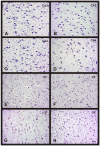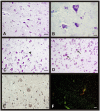Regional and Gender Study of Neuronal Density in Brain during Aging and in Alzheimer's Disease
- PMID: 27679571
- PMCID: PMC5020132
- DOI: 10.3389/fnagi.2016.00213
Regional and Gender Study of Neuronal Density in Brain during Aging and in Alzheimer's Disease
Abstract
Background: Learning processes or language development are only some of the cognitive functions that differ qualitatively between men and women. Gender differences in the brain structure seem to be behind these variations. Indeed, this sexual dimorphism at neuroanatomical level is accompanied unequivocally by differences in the way that aging and neurodegenerative diseases affect men and women brains.
Objective: The aim of this study is the analysis of neuronal density in four areas of the hippocampus, and entorhinal and frontal cortices to analyze the possible gender influence during normal aging and in Alzheimer's disease (AD).
Methods: Human brain tissues of different age and from both sexes, without neurological pathology and with different Braak's stages of AD, were studied. Neuronal density was quantified using the optical dissector.
Results: Our results showed the absence of a significant neuronal loss during aging in non-pathological brains in both sexes. However, we have demonstrated specific punctual significant variations in neuronal density related with the age and gender in some regions of these brains. In fact, we observed a higher neuronal density in CA3 and CA4 hippocampal areas of non-pathological brains of young men compared to women. During AD, we observed a negative correlation between Braak's stages and neuronal density in hippocampus, specifically in CA1 for women and CA3 for men, and in frontal cortex for both, men and women.
Conclusion: Our data demonstrated a sexual dimorphism in the neuronal vulnerability to degeneration suggesting the need to consider the gender of the individuals in future studies, regarding neuronal loss in aging and AD, in order to avoid problems in interpreting data.
Keywords: Alzheimer's disease; age; entorhinal cortex; frontal cortex; hippocampus; human; sexual dimorphism.
Figures






Similar articles
-
Hippocampal neuronal loss in the CA1 and CA3 areas of Alzheimer's disease patients.Psychiatr Danub. 2012 Jun;24(2):152-8. Psychiatr Danub. 2012. PMID: 22706413
-
Olfactory centres in Alzheimer's disease: olfactory bulb is involved in early Braak's stages.Neuroreport. 2001 Feb 12;12(2):285-8. doi: 10.1097/00001756-200102120-00021. Neuroreport. 2001. PMID: 11209936
-
An experimental model of Braak's pretangle proposal for the origin of Alzheimer's disease: the role of locus coeruleus in early symptom development.Alzheimers Res Ther. 2019 Jul 3;11(1):59. doi: 10.1186/s13195-019-0511-2. Alzheimers Res Ther. 2019. PMID: 31266535 Free PMC article.
-
Cerebral cortex pathology in aging and Alzheimer's disease: a quantitative survey of large hospital-based geriatric and psychiatric cohorts.Brain Res Brain Res Rev. 1997 Oct;25(2):217-45. doi: 10.1016/s0165-0173(97)00023-4. Brain Res Brain Res Rev. 1997. PMID: 9403139 Review.
-
GABAergic deafferentation hypothesis of brain aging and Alzheimer's disease revisited.Brain Res Bull. 1998;45(4):341-79. doi: 10.1016/s0361-9230(97)00347-x. Brain Res Bull. 1998. PMID: 9527011 Review.
Cited by
-
The Contribution of Plasma and Brain Vitamin C on Age and Gender-Related Cognitive Differences: A Mini-Review of the Literature.Front Integr Neurosci. 2020 Aug 21;14:47. doi: 10.3389/fnint.2020.00047. eCollection 2020. Front Integr Neurosci. 2020. PMID: 32973470 Free PMC article. Review.
-
Elucidating the Multi-Targeted Role of Nutraceuticals: A Complementary Therapy to Starve Neurodegenerative Diseases.Int J Mol Sci. 2021 Apr 14;22(8):4045. doi: 10.3390/ijms22084045. Int J Mol Sci. 2021. PMID: 33919895 Free PMC article. Review.
-
Distribution and inter-regional relationship of amyloid-beta plaque deposition in a 5xFAD mouse model of Alzheimer's disease.Front Aging Neurosci. 2022 Jul 28;14:964336. doi: 10.3389/fnagi.2022.964336. eCollection 2022. Front Aging Neurosci. 2022. PMID: 35966777 Free PMC article.
-
Truncated Dyrk1A aggravates neuronal apoptosis by inhibiting ASF-mediated Bcl-x exon 2b inclusion.CNS Neurosci Ther. 2024 Apr;30(4):e14493. doi: 10.1111/cns.14493. Epub 2023 Oct 21. CNS Neurosci Ther. 2024. PMID: 37864462 Free PMC article.
-
Circulating brain-enriched microRNAs as novel biomarkers for detection and differentiation of neurodegenerative diseases.Alzheimers Res Ther. 2017 Nov 9;9(1):89. doi: 10.1186/s13195-017-0316-0. Alzheimers Res Ther. 2017. PMID: 29121998 Free PMC article.
References
LinkOut - more resources
Full Text Sources
Other Literature Sources
Miscellaneous

